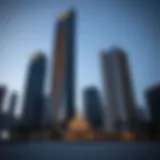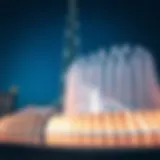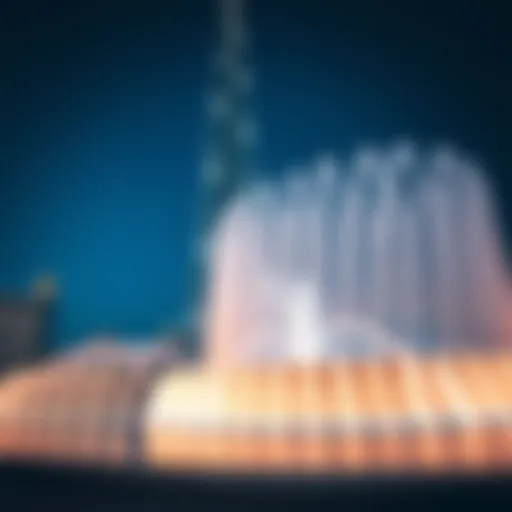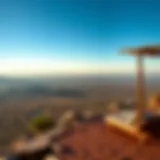The Clock Tower of Dubai: A Landmark on Sheikh Zayed Road
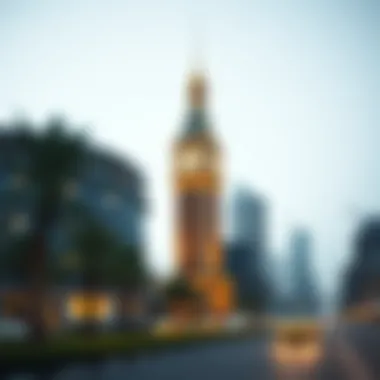

Intro
The Clock Tower on Sheikh Zayed Road is more than just a striking piece of architecture; it serves as a milestone in Dubai’s urban development and a testament to the city’s rapid growth. Standing tall amidst the hustle and bustle of one of the UAE’s busiest roads, this landmark embodies a unique combination of modernism and cultural significance that cannot be overlooked.
As lead traffic makes its way past this pivotal gathering point, the Clock Tower mirrors not just the time of day, but also the evolving narrative of Dubai itself. From its architectural elements inspired by Islamic design to its role in shaping nearby property values, understanding the Clock Tower is integral for investors and homebuyers alike. Let’s delve into how this iconic structure not only signifies the passage of time but also acts as a catalyst for real estate trends.
Market Trends
Current Market Analysis
In recent years, the property market surrounding the Clock Tower has experienced a noticeable upturn. With its prestigious location, properties nearby have seen substantial demand, attracting both local and international buyers.
- Increased Property Prices:Properties in close proximity to the Clock Tower have appreciated significantly, reflecting both desirability and the influx of businesses wanting to establish a presence in this bustling area.
- Rental Yields: Investors are noting rental yields above the national average, making this part of Dubai appealing for those looking to maximize their investment.
The heightened interest generated by the Clock Tower as a landmark has imprinted upon surrounding neighborhoods, making areas like Al Wasl and Zabeel especially attractive for prospective residents.
Future Projections
Looking ahead, the future of the property market around the Clock Tower seems bright. Expected developments in infrastructure and urban planning signal positive growth for real estate:
- New Transportation Links: The introduction of additional metro stations and road enhancements could further improve accessibility, drawing even more visitors and residents.
- Commercial Developments: A surge in commercial projects is anticipated, which will naturally complement the residential market by fostering a vibrant community that supports both living and working.
Given these trends, potential investors can expect further appreciation in property values.
Property Insights
Neighborhood Comparisons
When discussing the Clock Tower’s impact, it’s vital to consider its surrounding neighborhoods.
- Al Wasl: Known for its upscale residences, this area is favored by those looking for luxury with a hint of modernity.
- Zabeel: Offers a balance of residential and commercial spaces, benefiting from its strategic location near the Clock Tower.
- Downtown Dubai: Although a bit further, this area attracts many due to its dynamic atmosphere and proximity to shopping and entertainment.
Property Types Explained
In the vicinity of the Clock Tower, various property types cater to diverse preferences and budgets:
- Luxury Apartments: High-end living spaces are marketed toward affluent buyers seeking both comfort and chic living.
- Commercial Offices: Given the neighborhood’s bustling business activity, commercial office spaces are in high demand, appealing to enterprise-level operations.
- Mixed-Use Developments: These provide a convenient option for both residents and businesses, allowing for a modern lifestyle within walking distance of eateries and shopping.
The investment potential in these property types remains considerable, particularly as the area around the Clock Tower continues to flourish.
"An understanding of the Clock Tower’s significance is crucial for navigating Dubai's competitive real estate landscape."
In summary, the Clock Tower is not simply a spectator of Dubai’s relentless progress; it plays an instrumental role in shaping the urban and real estate scene. Its influence stretches beyond architectural beauty, directly impacting market trends and property dynamics in the vicinity.
Prologue to the Clock Tower in Dubai
The Clock Tower in Dubai is more than just a way to tell time; it’s a cornerstone of the modern urban identity of the city. Anchored prominently along Sheikh Zayed Road, it serves as a beacon for both local residents and international visitors. An exploration of its evolution not only reveals its architectural splendor but also underscores its significance in the cultural and economic landscape of Dubai.
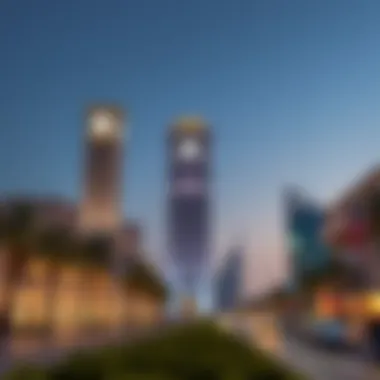

In this first section, we will delve into the historical context of the Clock Tower's construction, and the cultural importance it bears within UAE society. For investors, homebuyers, and analysts, understanding this landmark is crucial. Its presence indicates not just a pivotal point on the map, but also reflects the spirit of growth and innovation that Dubai embodies.
Historical Context
The story of the Clock Tower begins in the late 1990s, shortly after the establishment of Dubai as a global hub. Initial discussions surrounding its construction emerged as the city sought to modernize and assert its identity on the world stage. The Clock Tower was thoughtfully positioned at the junction where Sheikh Zayed Road splits into two important thoroughfares.
Built as part of a project to beautify the area, construction commenced in 1998 and was completed in 2001, during a period of rapid development. The structure stands out with its bold geometric designs and an impressive height, making it one of the tallest clock towers globally at the time. In its context, the tower became a landmark symbolizing progress, hope, and a nod to the cultural significance of time in Arab society.
Cultural Importance
The Clock Tower is not merely a physical structure; it embodies the very essence of Dubai's spirit. It has become a cultural icon, often featured in local artwork and literature, reminding residents and tourists alike of the city's history and aspirations. Festivals and public gatherings frequently take place in its vicinity, turning it into a community hub.
Notably, the tower symbolizes the fusion of tradition and modernity. It stands as a reminder of the old trading routes that once defined the region, marrying that history seamlessly with contemporary architecture. Visitors and locals alike utilize the tower as a meeting place, signifying its role in the daily lives of those in the city.
"The Clock Tower is not just about managing time; it reflects the heartbeat of Dubai’s urban jungle."
The cultural significance extends beyond everyday functionality; it portrays the ethos of the Emirate, embodying values such as diligence, innovation, and community. As such, it stands resilient against global and local changes, continuing to draw attention as a reference point in discussions about urban development and tourism in the region.
Architectural Features of the Clock Tower
Examining the architectural features of the Clock Tower sheds light on its significance not just as a landmark, but also as a functional and aesthetic addition to Dubai’s skyline. Its prominent location on Sheikh Zayed Road offers a stunning vantage point for tourists and residents alike. Furthermore, its design speaks to both tradition and modernity, reflecting Dubai's growth while honoring its roots. A closer look at the details can offer insights into its cultural resonance and its role in urban development.
Design Inspiration
The design of the Clock Tower draws inspiration from various architectural styles, beautifully merging classical and contemporary elements. The prominent clock face serves as a focal point, symbolizing the importance of time in a city that races forward at an exhilarating pace. Its towering aspect is reminiscent of traditional clock towers found across European cities, yet it incorporates local materials and motifs. The harmony between its historical influences and modern aesthetics suggests a bridge between past and future.
"The Clock Tower is more than just a timekeeping marvel; it is a canvas that reflects the intricacies of Dubai’s identity."
This amalgamation of styles effectively captures the essence of Dubai, where tradition meets innovation. It serves not just as a functional piece but as a conversation starter among visitors and residents.
Materials and Construction Techniques
When discussing the materials and construction techniques of the Clock Tower, one must recognize the careful selection that balances durability with elegance. The structure primarily utilizes reinforced concrete, a material that ensures longevity in Dubai's harsh climate. Meanwhile, decorative elements—such as glass and metal accents—were chosen not only for visual appeal but for their ability to withstand environmental factors.
The construction involved advanced engineering methods that reflect Dubai's reputation for pushing boundaries. Steel frameworks provide structural integrity while allowing for expansive clock faces that can be seen from great distances. This attention to both form and function ensures that while it captivates the eye, it also stands resilient against the test of time.
Technological Aspects
The technological components of the Clock Tower are noteworthy, seamlessly integrating modern innovations. The clock mechanism is crafted using advanced technology that allows for precision in timekeeping, which is essential for both residents and tourists. Moreover, the lighting system has been designed to highlight its features during the night, illuminating its stature against the dark skyline.
In addition to the clock itself, the surrounding areas are equipped with advanced smart technology, enhancing visitor experience. From wireless access points to apps that provide information about the building and its history, these elements enrich the overall ambiance. The blend of traditional clockmaking with modern tech reflects Dubai’s journey—as much a part of the city’s evolution as the structure itself.
By examining these architectural features, one gains insight into the Clock Tower's multifaceted nature. It is more than an aesthetic landmark; it is an embodiment of the city’s spirit, a testament to what Dubai represents today.
The Location of the Clock Tower
The location of the Clock Tower is not just a dot on a map; it's an integral part of Dubai's urban narrative. Nestled along Sheikh Zayed Road, this iconic structure serves as a compass, directing traffic flow and drawing visitors, business people, and investors alike. The importance of this site goes beyond mere beauty. It reflects Dubai’s rapid development and cultural evolution. This area is the hive of activity, bustling with life and opportunities.
Sheikh Zayed Road Overview
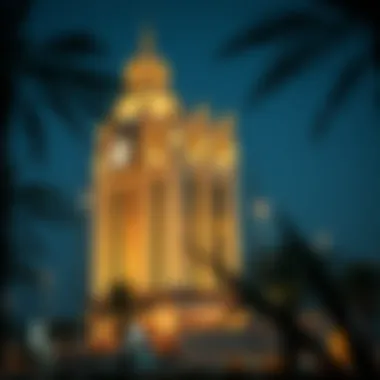

Sheikh Zayed Road, a lifeline of Dubai, stretches seamlessly through the city and connects key districts like Downtown Dubai and Jebel Ali. This highway is not merely a stretch of asphalt; it’s a metaphorical artery, pumping life into the surrounding areas. Towering skyscrapers, luxurious hotels, and bustling malls line the road, showcasing the city’s ambition and modern flair.
Looking around, visitors can effortlessly spot landmarks including the Burj Khalifa and the Dubai Mall, both of which add to the area’s allure.
- Economic Hub: Sheikh Zayed Road's strategic location makes it central to Dubai's economy. It hosts many corporate offices and embassies, making it a prime area for business ventures.
- Cultural Attractions: Alongside its economic significance, the road is rich in cultural experiences. Art galleries, museums, and theaters can be found in close proximity, attracting a diverse crowd.
The Clock Tower stands as a proud sentinel in this landscape. It symbolizes not just timekeeping, but also the metronomic rhythm of growth and development that pulses through the heart of this city.
Accessibility and Transportation Links
Accessibility is a crucial consideration for anyone looking to invest in real estate or business along Sheikh Zayed Road. The Clock Tower is exceptionally well-served by various transportation modes:
- Metro Stations: The proximity of the Dubai Metro stations ensures a continuous flow of commuters. The nearby BurJuman Station and Financial Centre Station cater to both residents and tourists, making it easy to pop in for a visit.
- Bus Routes: Numerous public buses travel along Sheikh Zayed Road, providing inexpensive access to and from the Clock Tower. Not to mention, Dubai's RTA bus service is known for its reliability and efficiency.
- Taxi Services: The availability of taxis around the area is another boon. Visitors can hail a ride conveniently, ensuring that reaching the Clock Tower is as smooth as silk.
Moreover, major hotel chains and business centers are just a stone's throw away, meaning that business conferences or casual meet-ups are always within easy reach. This level of accessibility draws not only tourists but also investors looking to capitalize on the flowing foot and vehicle traffic.
"The strategic location of the Clock Tower along Sheikh Zayed Road defines its role as a central landmark in Dubai's dynamic landscape."
The combination of commercial hubs, cultural attractions, and varied transportation options marks the Clock Tower as a must-see spot in Dubai. This blend of features plays a pivotal role in enhancing and sustaining property values in the vicinity, solidifying its status not just as a landmark, but as a vital component of Dubai's urban ecosystem.
Impact on Local Real Estate
The presence of the Clock Tower on Sheikh Zayed Road in Dubai has far-reaching implications for local real estate, shaping both the character of the area and the economic landscape. As an emblem of Dubai's growth and ambition, the Clock Tower does more than just mark time; it acts as a milestone in the property's evolving value and desirability. This section will detail how this landmark influences property values, commercial developments, and residential opportunities, providing insight to investors and potential homebuyers alike.
Property Values and Trends
Real estate in the vicinity of the Clock Tower tends to exhibit a steady appreciation over time. Homebuyers and investors often regard the area as a premium location; they believe that properties near prominent landmarks inherently hold more value. This is not merely anecdotal.
- Market Analysis indicates that properties located within a short distance from the Clock Tower command higher prices compared to similar properties in less iconic areas. Just as a moth gravitates toward a flame, so too do buyers seek locations associated with prestige and cultural significance.
- Recent Trends show that in the past few years, property prices in the immediate vicinity have seen an uptick of around 12%-15%. This incline is not just a feature of the market; it reflects the underlying demand for places that provide both commercial potential and lifestyle benefits.
"As new buyers gravitate toward areas with cultural markers, properties near the Clock Tower often benefit from an enhanced profile that boosts overall market sentiment."
Commercial Developments Nearby
The Clock Tower has sparked a flurry of commercial activity in its surroundings. Developers see it as a beacon for business opportunities, leading to a boom in office spaces and retail establishments nearby. Several factors contribute to this commercial transformation:
- Strategic Location: The Clock Tower's position along Sheikh Zayed Road, a major thoroughfare, makes it an ideal spot for businesses looking to attract both locals and tourists.
- Enhanced Foot Traffic: With tourists flocking to the landmark, businesses capitalize on the influx, leading to a myriad of shops, cafes, and entertainment venues sprouting up around it. This, in turn, draws even more tourists and locals, creating a vibrant commercial atmosphere.
- Developer Initiatives: Several recent projects, such as upscale shopping complexes and state-of-the-art office buildings, have been announced. The development initiatives aim to integrate life, work, and leisure, making the area a sought-after hub for both living and conducting business.
Residential Opportunities
Apart from commercial growth, the area surrounding the Clock Tower also presents exciting residential opportunities. Investors and homebuyers should consider the following:
- High-Quality Developments: New residential projects, including luxury condominiums and stylish apartments, cater to a diverse demographic. These buildings often include modern amenities, ensuring that residents can enjoy a comfortable lifestyle.
- Attractive Community Features: Living near the Clock Tower means access to numerous parks, restaurants, and recreational facilities, appealing to families and young professionals alike. This creates a sense of community which is often a deciding factor for buyers.
- Good Returns on Investment: Properties in this hot spot show strong rental demand due to the continuous influx of expatriates and tourists. Investors can expect solid returns, with rental yields often exceeding those in less desirable locations.
Visitor Experience
The visitor experience at the Clock Tower in Dubai encapsulates not just the architectural wonder, but also enriches the cultural fabric of the city. This magnificent landmark isn't merely a point on a map; it's a hub of activity, where tourists and locals alike converge to relish the vibrant atmosphere. The Clock Tower holds a pivotal role in shaping perceptions of Dubai, making it crucial to understand the various facets that define the visitor’s journey.
Tourist Attractions in the Vicinity
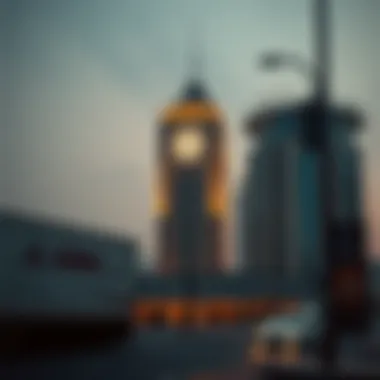

The area surrounding the Clock Tower is teeming with a myriad of attractions that draw visitors from around the globe. To really soak in the local culture, one can stroll through the nearby Al Rigga district, where the streets pulse with the sounds and sights of the marketplace.
- Dubai Museum: Just a short distance away, this museum offers a glimpse into the rich heritage of Dubai, showcasing traditional artifacts that highlight the city’s transformative journey.
- Deira Waterfront Market: For those looking to experience local flavors, this market provides an authentic taste of Emirati cuisine, alongside a vibrant mix of spices and crafts.
- Al Ghurair Centre: One of the first shopping malls in Dubai, it combines modern retail experiences with a hint of history, making it an attractive pitstop for visitors.
Exploring these nearby attractions gives tourists a full-bodied impression of Dubai, layered with historical and contemporary influences.
Events and Festivals at the Clock Tower
The Clock Tower also serves as a backdrop for various events and festivals throughout the year, enhancing its allure as a gathering place.
One noticeable event is the New Year’s Eve celebration, where the tower transforms into a focal point for fireworks. Thousands gather to witness this breathtaking spectacle, creating a sense of unity among attendees. Additionally, other cultural festivals, such as the Dubai Shopping Festival, highlight local talents through performances and exhibitions within the shadow of this iconic structure.
Furthermore, the Clock Tower plays host to art exhibitions and public celebrations during National Day, where the community comes together to celebrate local culture and traditions. These events are not only entertaining but also serve as important reminders of the heritage and identity that the Clock Tower stands for.
In summary, strategically positioned at the heart of Dubai, the Clock Tower provides visitors with vibrant experiences, from sightseeing and shopping to celebrating local culture. Its proximity to nearby attractions and its role as a venue for significant events solidify its status as a must-visit landmark, thus inviting investors, homebuyers, and cultural enthusiasts to recognize its transformative impact on the local landscape and economy.
Future Developments Around the Clock Tower
The future of the Clock Tower area on Sheikh Zayed Road is not just about the iconic monument itself; it’s about how this landmark fits into the fabric of Dubai's ever-evolving landscape. This section sheds light on plannned infrastructure projects and economic forecasts which will certainly influence its surrounding environment, making it a focal point for future real estate and commercial activities.
Planned Infrastructure Projects
Several significant infrastructure projects are outlined or underway to enhance the appeal and accessibility around the Clock Tower. These developments hold the potential to elevate property values and stimulate further investment in the vicinity. Among these initiatives are:
- Expansion of Public Transport: There are ongoing efforts to enhance the transport network through additional metro stations and improved bus routes. This would not only increase foot Traffic but also attract more visitors to the area.
- Pedestrian-Friendly Zones: Plans to create pedestrian-friendly pathways and green spaces aim to make the area more inviting for tourists and locals alike. This could enhance the aesthetic appeal and promote more outdoor events.
- Commercial Complexes: The introduction of new shopping malls and business centers is likely, reflecting the need for more mixed-use developments in the hub. Such establishments are expected to draw in both shoppers and professionals, fostering a lively community atmosphere.
These infrastructure enhancements are crucial; they promise to facilitate easier access and a more pleasant environment, ultimately benefiting property developers and investors.
Economic Forecasts
With the ongoing growth and investment predicted in the region surrounding the Clock Tower, a few trends can be anticipated. Experts forecast a rise in property values fueled by the expansion plans and increased demand from homebuyers and commercial entities.
- Rental Market Growth: As the area develops, new residential blocks will likely emerge, responding to the demand for high-quality living spaces. This demand could see rental prices increase, benefiting landlords and investors alike.
- Employment Opportunities: New commercial projects will create jobs, attracting a diverse workforce to the area. This influx of workers will further enhance the local economy, leading to more spending in businesses nearby.
- Overall Economic Activity: The combination of infrastructure improvements and new businesses is expected to energize the local economy. A vibrant economic environment typically contributes to increased investor interest, which can offer lucrative opportunities for those keeping an eye on market trends.
The future developments around the Clock Tower are not just transactions in real estate; they are the backbone of a broader vision of Dubai's advancement. They promise connectivity, growth, and a brighter economic landscape for years to come.
Culmination
In concluding this exploration of the Clock Tower, we highlight its profound significance beyond mere aesthetics. This landmark, perched prominently along Sheikh Zayed Road, serves as both a historical marker and a beacon of Dubai's rapid urbanization. Visitors and residents alike view it as a testament to the city’s ambition and growth.
Reflection on the Clock Tower's Legacy
The legacy of the Clock Tower transcends its physical structure. This monument is deeply intertwined with the evolution of Dubai itself. It stood witness as the city transformed from a small trading post into a bustling metropolis.
Key aspects to consider include:
- Cultural Symbolism: The Clock Tower represents Dubai's unique blend of tradition and modernity. It embodies a narrative that resonates with both locals and tourists.
- Real Estate Landscape: Its presence has significantly influenced property values in the surrounding areas. Investors should carefully consider how landmarks shape market dynamics, as this iconic structure has drawn developments and increased demand for real estate nearby.
- Future Development Prospects: As the city continues to expand, the Clock Tower is poised to remain a central figure in both cultural and economic discussions. Its ability to attract visitors ensures ongoing relevance.
In essence, the Clock Tower isn't just a watchful fixture of the skyline; it is a testament to the ambitions that drive Dubai forward. Its legacy provides valuable insights into the city's future for those keen on investing in or understanding the real estate landscape.
"The Clock Tower is not merely a monument; it's a reflection of our journey, a symbol that encapsulates our past, present, and future."
For those motivated to explore the impact of iconic structures on urban development, further reading can be found at Wikipedia on Dubai Landmarks and Britannica on UAE.
This deeper understanding doesn't just enrich appreciation of the landmark; it also provides critical context for investment decisions in a rapidly evolving real estate landscape.


